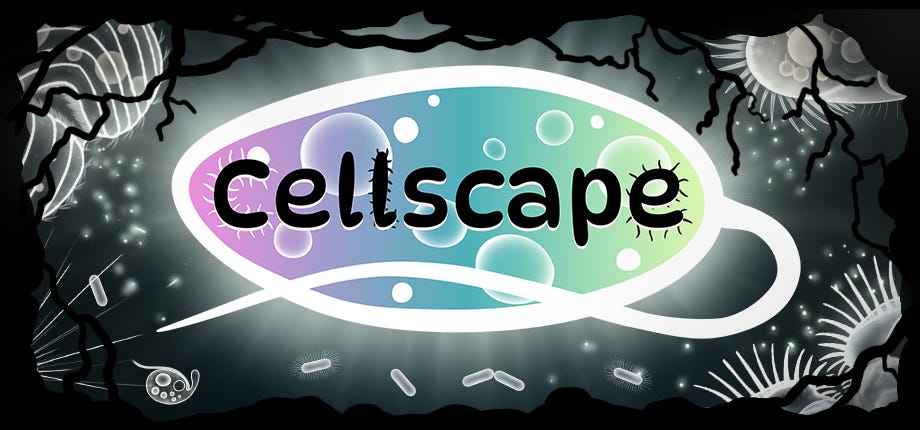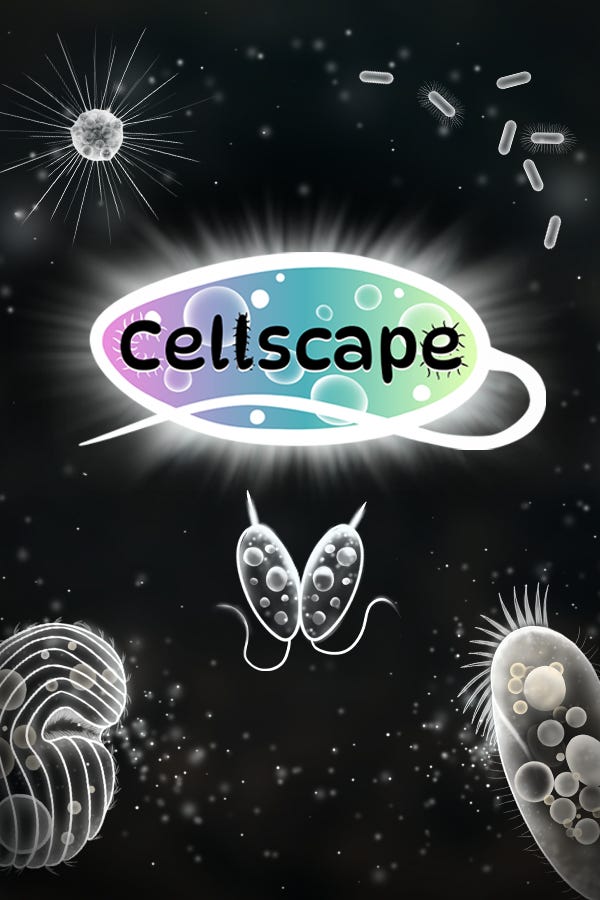Introducing Cellscape!
Launching my game's store page on Steam, and lots of new developments in the game
Hi everyone!
I’m so excited to finally share the title and logo of my microbe game, Cellscape!
The store page is now live on Steam, so please head over there and wishlist it if you want to get notified when the game is released!
Wishlisting helps tell Steam that people find this game interesting, so it’ll be more likely to show it to others once it launches. It also helps me stay motivated during development, knowing that lots of people are waiting to play in the digital microverse.
So if you have a Steam account and you’re even the slightest bit interested in Cellscape, please add it to your wishlist! Thank you so much 🥰
Game Updates
Since the last update I spent a lot of time working on building the Steam page, and I also started on some of the less exciting but very important parts of the game, such as the main menu and the in-game user interface. I added a couple of new creatures too!
Here’s an overview of what’s new:
Artwork
Steam required a variety of images to be used in different contexts around the site, so I spent a few days working on those in order to set up the page. This part was kind of intimidating since I’m not at all comfortable with graphic design, but Steam does a wonderful job providing easy to use templates and specific instructions. That helped a lot with both the technical side and how to approach each design.
Interactive Main Menu
In the spirit of finding interesting things in places one doesn’t normally pay attention to (like soil life), I decided to add some life to the start menu.
I added a bunch of loose mineral particles and some bacteria spawners to the scene. While the menu is open, the bacteria will gradually increase in number and assemble the particles into soil clusters.
Here’s a time lapse at 1500% speed to show the effect:
That little flagellate wasn’t actually supposed to be in the scene here, but I thought it was cute so I left it in for the video!
And speaking of flagellates, clicking anywhere outside the menu area will spawn flagellates that will swim around and eat the bacteria.
Finally, the buttons are animated to look like they have cilia which activate when you hover the mouse over, as you can see at the end of the video above.
The look of the menu itself will probably evolve over time, but at least this is a (mostly) functional prototype. The start and quit buttons are working already, but I haven’t added a settings menu or the ability to save the game yet, so the ‘Continue’ and ‘Options’ buttons are just decoration for now.
I also need to make it so you can bring up this menu by pressing ESC during the game.
Working on the menu screen gave me the idea to add a sort of “aquarium mode” to the game, because I found it surprisingly fun and quite relaxing to just sit and watch the little virtual microbes do their thing. That will be a side project for later :)
Score Tracker and Boost Indicator
We now have two working UI elements, the division progress/score tracker, and the boost indicator.
The first one is on the bottom left of the screen. The blue progress bar fills up as you eat bacteria, so you can see how close you are to dividing again. Then when you divide, the number at the bottom changes to show your updated score, and the bar rolls back to start again.
The boost indicator is only visible when you have boost to use (speed boost “fuel” comes from eating special booster bacteria).
As you can see in the video, the indicator pops up in the bottom right corner once you have some boost available. When it’s full, it pulses a little to remind you that it’s full and you can’t gain any more boost until you drain some. Pressing space drains the boost fuel, and when it’s empty the indicator disappears again to keep things neat and tidy.
Game Plan and Ecosystem Management
With the very minimum game mechanics in place and looking promising, it was time to make a clear overall plan for the game. I took some time to write out about seven stages that the game will progress through. These are based on milestones rather than strictly defined levels, so as a player you probably won’t be able to tell exactly which stage you’re at. And just like real ecosystems, it may not be linear, and could potentially progress either forward or backwards depending on what’s happening to the system.
I won’t share many details about this plan because it will contain a lot of spoilers, and much of it is just ideas at this stage, but I will say it felt absolutely fantastic to have developed this plan and be able to see a clear picture of how the entire game will play out from start to finish.
Having this overview meant I could start putting some actual structure into the game. I’m working on setting up a system where certain events such as unlocking new creature types will be triggered based on reaching specific milestones. For example, the first predator might spawn only when there are enough of the first type of flagellates on the scene.
This system is still very much a work in progress and it will take quite a lot of tinkering to get things right, but ultimately it will create a dynamic ecosystem, and the game will be a little different each time you play. Not by random chance, but by ecology.
New Creatures!
Finally, there are now two new creatures in the game!
The rotifer is more of a final boss-type creature which will bring a lot of chaos into the end stages of the game, so I was jumping ahead quite a bit by working with this one already. I basically did it because I wanted to test how it would be to draw and animate a creature with many body parts.
I was able to get the body to flex the way I wanted, and I set up a gentle side to side swaying animation. The cilia at the top will of course be animated as well later on, but that’s on the back burner for now.
The idea is to have it pull you in, spin you around a little, then throw you away. If it pulls you in too close to the center though, you’ll get swallowed up. You should also be able to escape its pull as long as you don’t get too close, or if you have some boost available to use.
The other new creature is the second flagellate, and it’s kind of a pain in the butt. It moves and reproduces fast, and has a larger detection range for bacteria than the first flagellate. If this one gets too abundant, it can actually become hard to find bacteria to eat. At that point you have to hope some predators will show up soon and get them under control!
That’s all for now! I’m off to see if I can fix some pesky bugs (my bacteria have randomly started disappearing, and I don’t know why!).
Thank you for being here and for joining me on this journey, I appreciate your support so much! 💕




Congratulations!
Wow this is cool stuff!